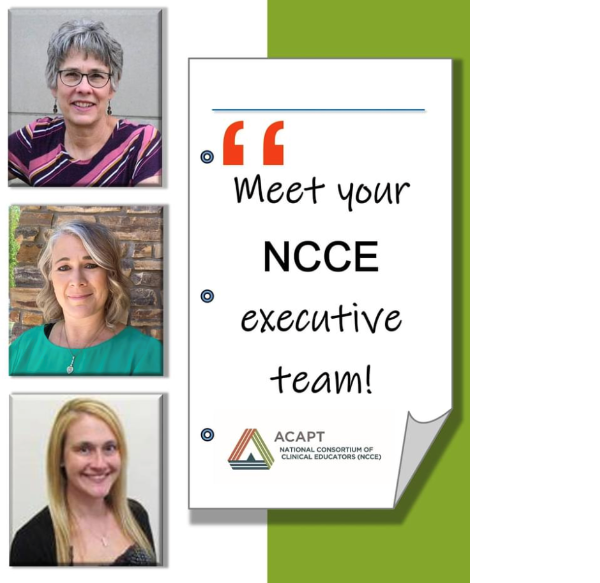ACAPT interviewed the National Consortium of Clinical Educators (NCCE) executive leadership to find out what led them to clinical education, how COVID-19 has changed their profession and what the NCCE’s priorities are.

- Janice Howman, NCCE Chair
- Tawna Wilkinson, NCCE Vice Chair
- Jamie Bayliss, NCCE Secretary
Watch a short excerpt from our NCCE discussion about how the COVID-19 crisis pulled the NCCE community together even more.
How did you get interested and involved in clinical education?
For those interested in direct mentoring and guiding students, clinical education is a great fit. Being involved in clinical education is a perfect mix of education, academia and clinical practice.
Janice came up through the ranks as a clinical instructor (CI), then a site coordinator of clinical education (SCCE) and an academic coordinator of clinical education (ACCE), and finally a director of clinical education (DCE). (See the ACAPT glossary of clinical education terms.)
Taking the credentialed CI program (CCIP) was a pivotal moment that expanded her skills and reinforced her decision to focus on clinical education. “I was so excited about not only helping the students, but mentoring the clinical instructors too,” says Janice.
Watching students grow in the clinic, not just the classroom
“I love seeing students grow professionally from start to finish,” says Tawna. “Watching them walk across the stage at graduation is a rewarding moment in their and my journey.”
In their roles, each NCCE leader enjoys being hands-on, cheerleading and figuring out how to both challenge and encourage their students.
Diversity in the work
In clinical education, there’s never a dull moment. “There are a lot of moving parts that are fun to manage,” says Tawna. “Everything from working with students to partnering with clinics to integrating with the academic program.”
What skills are important to be a successful clinical educator?
If you enjoy teaching and mentoring your patients, you may be a good fit for clinical ed. Other characteristics for an effective clinical educator include:
- Critical clinical teaching skills – Meet students at their level and determine how they learn best and how they best receive feedback.
- Excellent communication skills & transparency
- Passion to contribute to the profession & next generation
- Being approachable
- Professionalism with solid interpersonal abilities
- Ability to navigate different personalities
- Highly collaborative
Successful clinical educators are also skilled at both providing AND receiving feedback. “To be a good clinical educator, you need to be open to constructive feedback,” says Jamie. “You need to meet students at their level and understand that you can learn from them.”
Clinical instructors can use their traditional PT diagnostic skills to develop a “learning diagnoses” for their students. They can take their PT training to a different level to prepare and inform their pupils in the clinic.
COVID-19 impact on clinical education
Clinical education has faced challenges in the past and to some extent, the pandemic heightened some of those hurdles and forced adaptability for not only CIs, but the students. “We learned to always have a plan B & C,” says Tawna.
“We also started asking ourselves, what can we do differently?” says Tawna. The length of the clinical experience is one area PT educators are studying more. How many weeks are needed? And what does that time need to cover? Educational institutions are collecting good data now to fully answer these questions.
“I think COVID-19 forced us to be more creative and innovative,” says Janice. “We started using simulation for remediation experiences – and it worked well.” Telehealth is also a learning opportunity for students and has challenged them to expand and hone their verbal communication with patients.
The virtual experiences can never fully replace the hands-on experience, but it does force students to focus on different skills than at a physical clinic. Simulation has been a nice addition to help develop students’ clinical reasoning, where you think through the process and use your knowledge to develop a plan of action and educate patients effectively.
“It’s not just the hands-on and physicality of being in the same room as a patient,” says Jamie. “They need to be pushed outside their comfort zone to appreciate ambiguity a bit more. The old norm will not be the new norm.”
Throughout the pandemic, educators have relied on each other for advice and even consolation. “The crisis didn’t pull us apart, it pulled us together,” says Janice. “We’re all jointly figuring out the best path forward.”
Watch a short excerpt from our NCCE discussion about how the COVID-19 crisis pulled the NCCE community together even more.
More about the ACAPT National Consortium of Clinical Educators (NCCE)
NCCE aligns with the ACAPT strategic goal of pursuing excellence in PT education. From the ACAPT strategic plan, NCCE is focused on developing the “framework to transform clinical education.”
As an action-oriented group, NCCE is always striving for improvement. NCCE’s members, board and volunteers are a passionate, fun group that love making connections and learning from each other. The board, including directors-at-large (DALs), meet at least annually at the Educational Leadership Conference (ELC). NCCE has also developed a strong national network by partnering with regional clinical education consortia.
NCCE’s strategic drivers include:
- Academic/clinical partnerships
- Clinical education research
- Communications
- Leadership development
NCCE contributes to clinical/academic partnership by ensuring equal representation with academia in the PT program, and engaging multiple stakeholders in their work. The clinical voice is grassroots and a vital part of the PT education experience.
Recent work has been focused on: